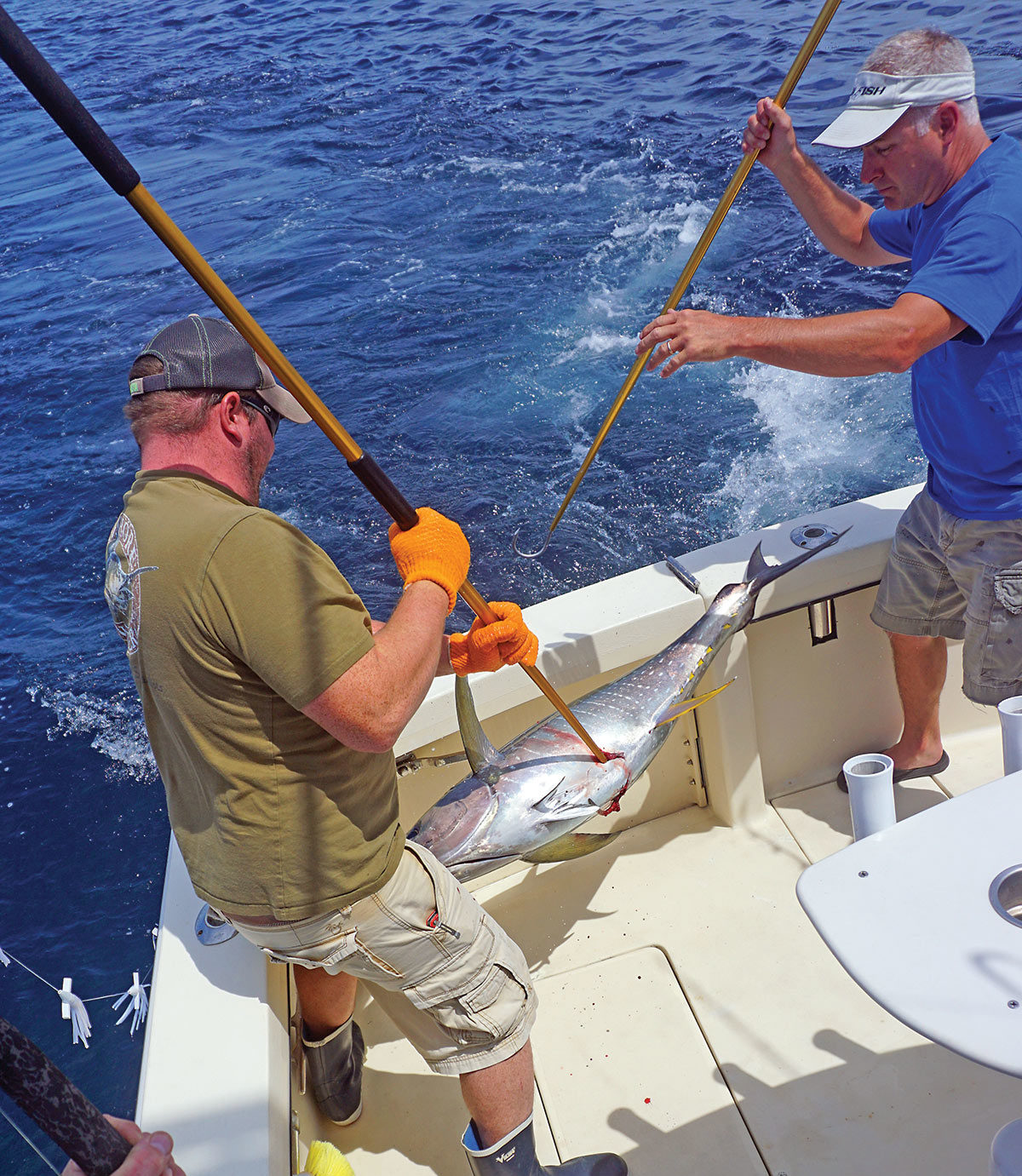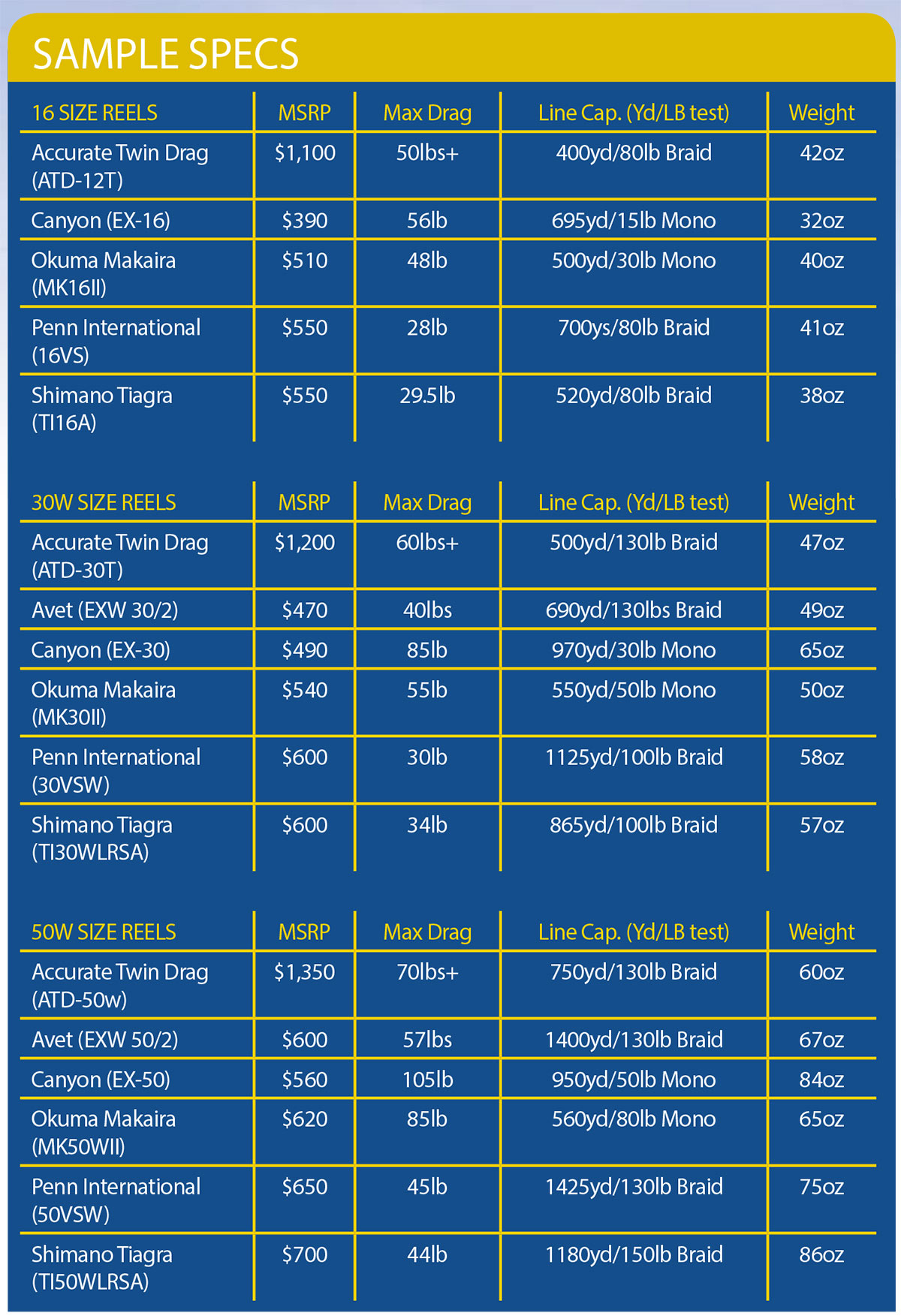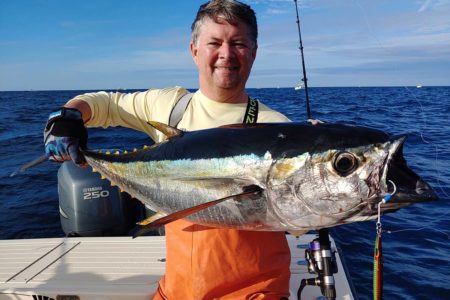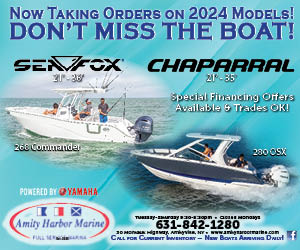
The pros and cons of the classic 30W/50w stand-up gear and smaller, lighter 16 size reels—let the mid-shore tuna battle begin!
Ah, the classic big gold reel loaded with pink Ande mono on a 50-pound class stand up rod. This has been the trustworthy standby for years. However, setups like this have had some advancements in the technology of reel and rod construction, making them lighter and stronger overall.
Shimano and PENN for example are two of the biggest rod and reel manufacturers in the industry; for decades, they have made reliable and exceptional offshore gear. While their respective Tiagra and International lines have always been two of the more popular selections in the offshore arena, more and more you’ll now find the likes of Accurate ATD, Okuma Makaira, Avet’s EXW, Alutecnos and the Canyon EX series in big game cockpits as anglers look for the latest new gear options to put to the test.
With the new advancements in fishing technology, manufacturers have continued developing smaller, lighter reels. Smaller and lighter reels call for smaller and lighter rods as well, which makes them more comfortable to hold over longer periods of fishing time or when fighting big fish. Tiagra and Internationals in the 16 to 20 size range have become popular, along with other new “big reels in a small packages” like the Maxell Ocean Max, Avet, Accurate, Okuma or Seigler OS Offshore Series reels for jigging.
Consider that reels in the 50W size range have max drags between 40 and 50 pounds, which is typically much higher than needed for most anglers. The smaller reels are putting out 25 to 30 pounds of drag, which is still plenty of drag for small to medium sized tuna. But the question that many anglers have is, are these smaller setups a sufficient replacement for the tried and true classics?
Bigger Benefits

There are many reasons why the larger 30W and 50W reels have been popular for so long. One reason is line capacity. If using only monofilament line, 30W reels can fit roughly 500 yards of 50- or 60-pound mono and 50W reels can fit about 500 yards of 80-pound mono. When using a braid or hollow core backing, fishermen can fit about 500 yards of 130-pound hollow core with a 100-pound, 150-yard top shot of mono on top. Not only can anglers fit more line on the reel this way, but this also allows anglers to use a line with a higher strength.
Another advantage of the larger size reels is the increased drag at strike and at full. Larger reel frames allow larger drag washers to be added, which means more drag overall. While smaller reels do provide drag that is usually more than enough for small and medium tuna, it is nice to have the extra little bit if necessary.
Larger rods and reels also have more stopping power overall. Heavier rods, heavier line, and more drag can really put some heat on a fish if necessary. The heavier rods also open the door to bent-butts, which can add a serious advantage when it comes to fighting fish with bucket harnesses or fighting chairs. This can lead to shorter fight times and more time with lines in the water.
When Big’s Not Better
While the larger 30W and 50W combos are effective for a wide array of fishing, they definitely aren’t the perfect solution for everything. One reason some people are opting for smaller setups is because the larger ones are double – if not more – the weight of the 16 size reels. When fighting a fish for a while, that much weight could cause fatigue. Take for example holding a 6-ounce sinker straight out in your hand. Not too heavy right? Initially, it takes little to no effort to hold that sinker. After a little while, that sinker will slowly get heavier in your hand; the same concept applies to rods and reels.
Another not-so favorable side of the larger setups is that they’re mainly catered toward trolling. When spooled with 80-pound mono or even 100- to 130-pound top shots, it doesn’t make for a favorable jigging or chunking setup. The bait presentation won’t look as natural when compared to being jigged or chunked on 30- or 40-pound leader.
One other drawback of the bigger reels is the cost. Fishing isn’t a cheap sport to begin with, especially on the offshore grounds. When it comes right down to it, every dollar counts for most of us recreational guys. A Shimano Tiagra 50W retails for roughly $850 to $900, multiplied by an eight-rod spread that’s almost $6,000 in just the reels, before considering the rods, line, lures, and terminal rigging. Of course, with proper care and maintenance, these reels will last a lifetime.
And Light Is Right
One obvious advantage to smaller and lighter setups is the weight and size. With a Tiagra 16 weighing in at less than half the weight of a 50W, it ultimately provides the angler an easier time handling the gear without getting as fatigued. Anglers can also strip off the tuna fishing line and use those reels in the fall for bass trolling if they wanted to use it for more than a few months out of the season.
Another great aspect of these smaller reels and setups is that they are great for jigging and chunking. The lighter line and lighter leaders allow for a better and more natural presentation of baits and jigs. The lighter setups also let the angler feel the bait and lure a little bit better than the large rods/reels and heavy line. This could make a huge difference on days when the fish are finicky and leader shy. The smallest differences in bait presentation could have a huge impact!
Cost can also be an advantage when it comes to smaller gear. A size 16 Tiagra retails for between $600 and $650, about $200 less than a 50W, a savings of around $2,000 when outfitting that eight-rod spread. The rods paired with these reels typically don’t have roller guides either, so that could also save in cost too.

Smaller Disadvantage
While the smaller setups do have advantages over bigger gear, there are some drawbacks that cause anglers to stay away. One of the obvious and most important drawbacks of the smaller gear is the line capacity. Even with lighter pound test hollow core, some of these smaller reels can only hold the amount of line that the big reels can hold of heavier mono alone. This makes them unsuitable for trolling canyons or for larger size fish when there is already sometimes 75 to 100 or more yards of line out to start.
Another reason that fishermen will choose larger reels over smaller models is the increased max drag. The difference in drag at strike and max between the bigger and smaller reels is more than 10 pounds. While it is rare that anglers will ever use max drag, it’s nice to have the extra room. I think of it this way; you can tow a 28-foot boat with an F150, but it’s nicer to tow it with an F350. In some instances, the max drag on a 16 size reel is what the strike drag is set at on some the 50W reels!
Rod selection and configuration can also be a drawback for the smaller gear. Typically, smaller reels in the 16 size aren’t put on bent butts, and there aren’t a lot of different selections on roller guides either. Roller guides and bent butts are usually saved for the bigger guns. Not that these things are necessities, some anglers prefer to have rollers on some rods or have the ability to have a bent butt for certain applications.
Weighing the Options

When it comes to choosing setups to add to the offshore arsenal, there really is no one-size-fits all option. You can kill a mosquito with a sledge hammer, but you don’t want to bring a knife to a gunfight either. If fishing for small to medium size school tuna, the smaller setups may work just fine. They would also be great for trolling Clarkspoons and small feathers for bonito and some mahi on the inshore grounds. However, the larger setups will also work just fine for that size tuna. This may be a time when braid or hollow core backing may not be needed on the bigger reels.
The nice thing about the heavier gear is that even if an angler mainly fishes inshore and mid-shore, they could always put some braid or hollow core backing on and then they’ll have canyon setups ready to go!
While I don’t get out fishing as much as I’d like, I get out enough to be able to put some fish on the deck and have fun! Since we fish a smaller boat – a 26-foot center console with twin outboards to be exact – it is rare that we fish the canyon. The mid-shore grounds in the 30- to 60-mile range seem to be where we spend most of our time. While our arsenal consists of setups from smaller 16, 20, 25, and 30 size Tyrnos and TLD setups (spooled with mono between 30- and 50-pound), our usual loadout consists of four 30W Tiagras and three 50W Tiagras when targeting tuna. The smaller 30W setups are used for flatlines and short-baits, with the 50W used for way back and heavy lures or diving plugs.
When specifically targeting smaller pelagic species like bonito, mahi, and false albacore along the inshore grounds (15 to 25 miles out), we will opt for the 16, 20, 25, and 30 size Tyrnos and TLD reels. It’s nice to have some fun with the smaller pelagics, but it is also reassuring to know that these rods and reels can handle tuna if needed!
Our 30W and 50W reels are spooled with 60- and 80-pound mono, and no backing. Some say we’re crazy for going out without hollow core backing, but we aren’t targeting large fish or fishing canyons. There definitely is a chance though that there could be that lone big bluefin on the mid-shore grounds, and it’s happened before! We haven’t boated anything too big yet but we have had fish upwards of 80 pounds with no problems at all. Hollow core backing is in the future; the initial cost is the only thing keeping all mono on the reels right now!
When it comes down to it, the decision really depends on what kind of fishing you plan to do and what fits best in the budget. One thing is for sure though; no matter what setups are being used, getting out and putting time in out there is time well-spent.
| TACKLING BLUEFIN |
|---|
|
Something to note when fishing for bluefin, the limits are stricter than those of yellowfin and other tunas. This leads to releasing more fish than an angler typically would when fishing for other tuna species or mahi. I specifically don’t like using lighter gear for bluefin because if I want to release a fish, I like to crank it in relatively quickly and not “play” the fish near exhaustion. Shorter fight times also means more time with lines in the water! – J. Mitchell |




